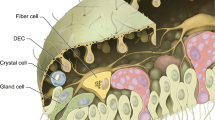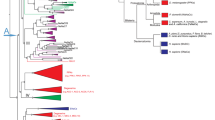Abstract
Trichoplax adhaerens is a member of the phylum Placozoa, an enigmatic group of benthic animals with remarkably simple morphology. While initial work on these organisms has primarily focused on their morphology and the development of genomic resources, Trichoplax has received increased attention as a model for studying the evolution of nervous and sensory systems. This work is motivated by the fact that Trichoplax features distinct behaviours and responses to environmental stimuli. Therefore, much progress has been made in recent years on the molecular, cellular, and behavioral understanding of this organism. Methods outlined here provide hands-on approaches to cutting edge molecular and cellular techniques to record cellular activities in Trichoplax.
Access this chapter
Tax calculation will be finalised at checkout
Purchases are for personal use only
Similar content being viewed by others
References
Syed T, Schierwater B (2002) Trichoplax adhaerens: discovered as a missing link, forgotten as a hydrozoan, re-discovered as a key to metazoan evolution. Vie Milieu 52:177–187
Schierwater B (2005) My favorite animal, Trichoplax adhaerens. BioEssays 27:1294–1302
Fortunato A, Aktipis A (2019) Social feeding behavior of Trichoplax adhaerens. Front Ecol Evol 7:19
Senatore A, Reese TS, Smith CL (2017) Neuropeptidergic integration of behavior in Trichoplax adhaerens, an animal without synapses. J Exp Biol 220:3381–3390
Smith CL, Pivovarova N, Reese TS (2015) Coordinated feeding behavior in Trichoplax, an animal without synapses. PLoS One 10(9):e0136098
Smith CL, Reese TS, Govezensky T et al (2019) Coherent directed movement toward food modeled in Trichoplax, a ciliated animal lacking a nervous system. Proc Natl Acad Sci U S A 116:8901–8908
Varoqueaux F, Williams EA, Grandemange S et al (2018) High cell diversity and complex peptidergic signaling underlie placozoan behavior. Curr Biol 28(21):3495–3501
Grell KG (1984) Reproduction of placozoa. In: Engels W (ed) Advances in invertebrate reproduction. Elsevier, Amsterdam, pp 541–546
Signorovitch AY, Dellaporta SL, Buss LW (2005) Molecular signatures for sex in the Placozoa. Proc Natl Acad Sci U S A 102:15518–15522
Eitel M, Guidi L, Hadrys H et al (2011) New insights into placozoan sexual reproduction and development. PLoS One 6(5):e19639
Jackson AM, Buss LW (2009) Shiny spheres of placozoans (Trichoplax) function in anti-predator defense. Invertebr Biol 128:205–212
Srivastava M, Begovic E, Chapman J et al (2008) The Trichoplax genome and the nature of placozoans. Nature 454:955–959
Ruthmann A, Terwelp U (1979) Disaggregation and reaggregation of cells of the primitive metazoan Trichoplax adhaerens. Differentiation 13:185–198
Smith CL, Varoqueaux F, Kittelmann M et al (2014) Novel cell types, neurosecretory cells, and body plan of the early-diverging metazoan Trichoplax adhaerens. Curr Biol 24:1565–1572
Grell KG, Ruthmann A (1991) Placozoa. In: Harrison FW, Westfall JA (eds) Microscopic anatomy of invertebrates. Wiley-Liss, New York, pp 13–28
Armon S, Storm Bull M, Aranda-Diaz A et al (2018) Ultrafast epithelial contractions provide insights into contraction speed limits and tissue integrity. PNAS 115(44):E10333–E10341
Senatore A, Raiss H, Le P (2016) Physiology and evolution of voltage gated calcium channels in early diverging animal phyla: Cnidaria, Placozoa, Porifera and Ctenophora. Front Phys 7:481
Wong YY, Le P, Elkhatib W et al (2019) Transcriptome profiling of Trichoplax adhaerens highlights its digestive epithelium and a rich set of genes for fast electrogenic and slow neuromodulatory cellular signaling. Preprint at https://doi.org/10.21203/rs.2.14504/v1
Senatore A, Boone A, Lam S et al (2011) Mapping of dihydropyridine binding residues in a less sensitive invertebrate L-type calcium channel (LCav1). Channels 5:173–187
Author information
Authors and Affiliations
Corresponding author
Editor information
Editors and Affiliations
Rights and permissions
Copyright information
© 2021 Springer Science+Business Media, LLC, part of Springer Nature
About this protocol
Cite this protocol
Gauberg, J., Senatore, A., Heyland, A. (2021). Functional Studies of Trichoplax adhaerens Voltage-Gated Calcium Channel Activity. In: Carroll, D.J., Stricker, S.A. (eds) Developmental Biology of the Sea Urchin and Other Marine Invertebrates. Methods in Molecular Biology, vol 2219. Humana, New York, NY. https://doi.org/10.1007/978-1-0716-0974-3_18
Download citation
DOI: https://doi.org/10.1007/978-1-0716-0974-3_18
Published:
Publisher Name: Humana, New York, NY
Print ISBN: 978-1-0716-0973-6
Online ISBN: 978-1-0716-0974-3
eBook Packages: Springer Protocols




